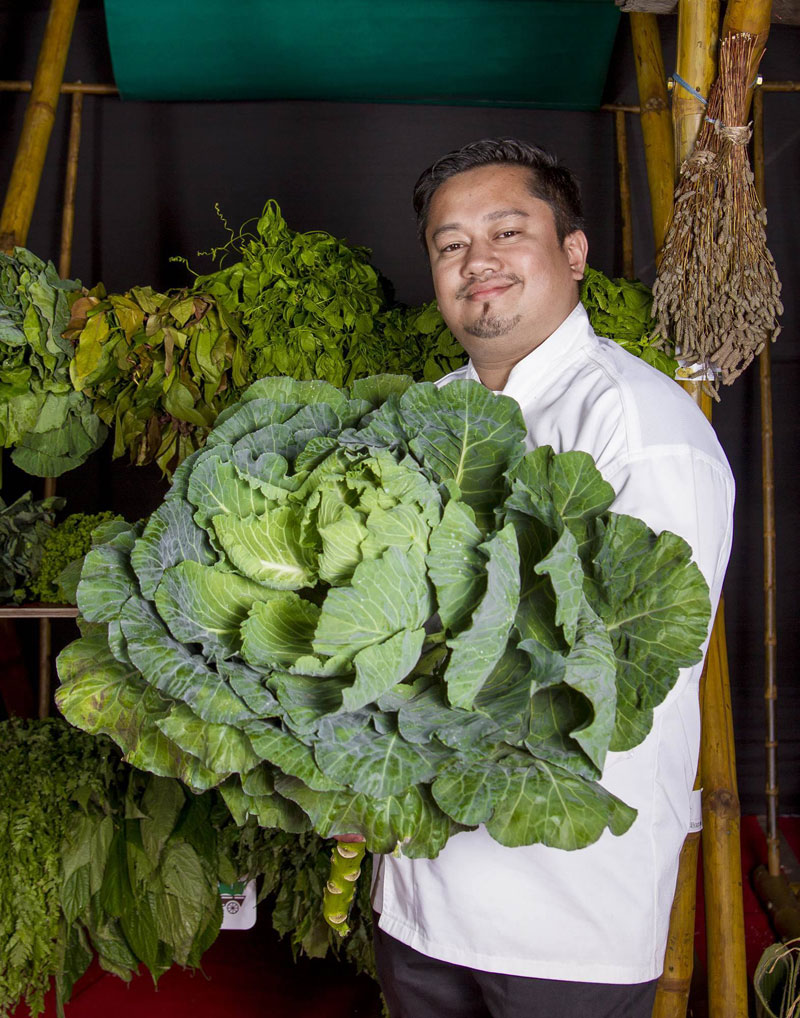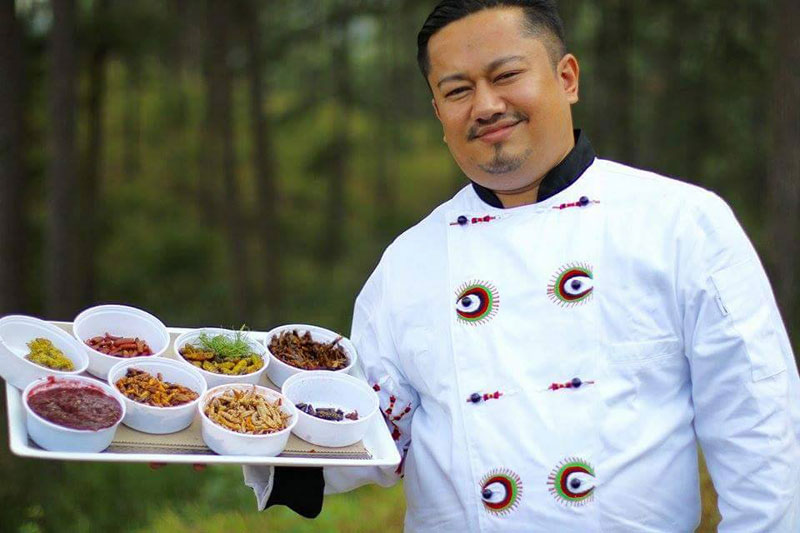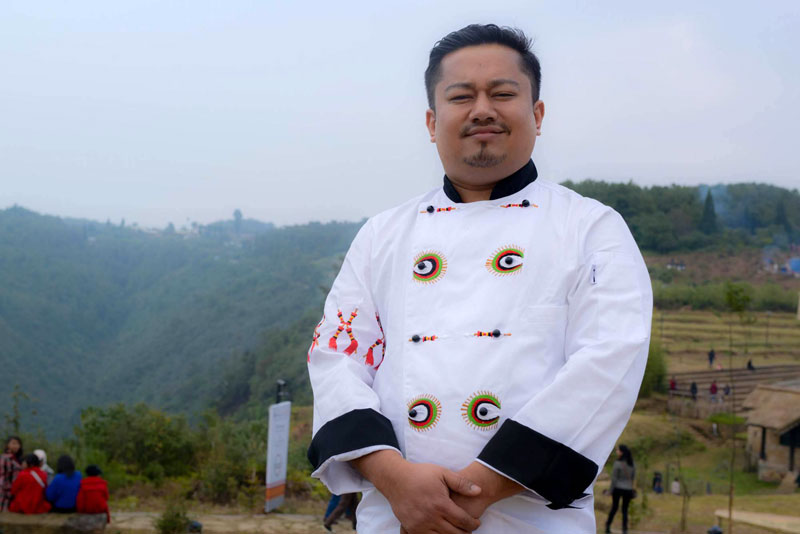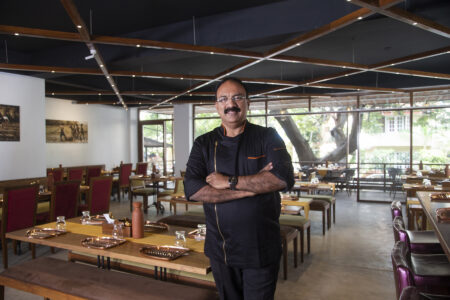The bar at the historic Pinewood Hotel in Shillong, Meghalaya, with its old world colonial atmosphere was the most happening place during the Mei-Ramew Festival. Every evening, delegates from different countries –growers and producers, academics, chefs, writers and journalists could all be seen converging there to exchange stories over drinks. Kaveri Ponnapa shared a table with Chef Joel Basumatari from Nagaland, who runs a restaurant in Dimapur, and has been delving deep into the cuisine and cooking techniques of the North East. Basumatari is one of a growing number of chefs who are returning to their traditional cuisines for inspiration.
Kaveri Ponnapa – When did your interest in cooking begin?
Joel Basumatari (laughing): At the age of 5, I got lost in a restaurant. Everyone started searching for me, and I was found in the kitchen, watching what was happening there.
KP – Where did you train and start your career as a chef?
JB –I studied Hospitality Management at IIHM, Calcutta and in 2007, armed with my Diploma, I went to the Thames Valley University, London. I spent a year at the Marriott, Regent’s Park and two years as Chef de Partie at the Crown Plaza, Heathrow.
KP –How did you decide to set up an independent restaurant? It must have been a challenge, and what kind of cuisine did you plan to serve?
JB –In April 2012, I returned to Dimapur, Nagaland. I saw that there was really no good restaurant where people could go out and eat. I wanted to create such a place. In October 2012, I opened Smokey Joe’s Restaurant and Grill. It was entirely self-funded, and I started with modern European, Spanish, French and Mexican food.
KP –What made you introduce elements of North East cuisine to your menu?
JB –After about a year of running my restaurant, I met the NESFAS (North East Slow Food and Agrobiodiversity Society) team. I began to work with them, holding community workshops with men and women from the villages, teaching them how to use flavours, plate and present food. I also started to learn a lot from them. I spent a lot of time with local people in the villages understanding their produce. There was so much variety and potential, I began changing a few elements of dishes at my restaurant to include these flavours.

KP –What are some of the local ingredients that we are likely to find in dishes at your restaurant?
JB –I use pork and bamboo shoot, something that is very popular right across the North East. Local coriander and mint have very unique flavours and feature in some dishes, as does sweet potato. I also make salads using indigenous greens such as pennywort and edible fern, as well as varieties of beans and mushrooms.
KP –Have you been able to carry this interest in local cuisine out of Nagaland?
JB – In September 2015, we held a very successful food festival, “Jewels of the North East”, at ITC’s Sonar Bangla, Kolkata in collaboration with the chefs of ITC hotels. We showcased eight of the North Eastern States. The menu included typical dishes such as Awoshi Kipiki Ngo Axone, smoked pork with fermented soya bean from Nagaland, and several other dishes from across the region like Jadoh, a Khasi rice dish. I also experimented with traditional flavours: for instance, stir-fried beef tenderloin with Naga herbs, and Rosella, which is common in this area, made into cream cheese shots. Also, in October 2014, 13 representatives from NESFAS showcased local food, including insects, at Terra Madre,Turin.
KP –What strikes you most about your journeys into the food of this region?
JB –The cultural diversity of the tribes and the dishes they cook. They may cook with the same ingredients, in a similar way, but the results are always different, depending on the location and the tribe.

KP –Is there a particular dish that stood out from amongst the many that you tasted and tried?
JB – There’s a way of cooking fish in a bamboo shaft called Angu Pongsen. The ingredients are dried bamboo shoot, local hot garlic, mashed chillies, fish, salt and edible fern. The bamboo used is a specific variety and size. The ingredients are stuffed into the bamboo along with the fresh catch of the day and a stopper made of wild leaves to seal it. It is then placed on the fire and cooked. No water is used, but the bamboo releases its juices and flavours the fish. This dish has been included in the Ark of Taste that documents the disappearing ingredients and cooking techniques of cultures.
KP –Do you see a growing interest in the food of the North East?
JB –I think there is a space for North East cuisine in the global market. We have to keep our cuisine alive, innovate, but we cannot change the essence of the original dish. There is also plenty of local interest: the Morung Festival, for instance, where 13 tribes participated in a cooking competition in early December 2015. Then there is Naga Chef, a local cooking competition that has been running successfully for the last three years in Kohima. This year I was the head judge, and was also involved in mentoring the participants. There were some interesting innovations like a cake made of local millets.
KP –Is there anything else that captures your interest, apart from ingredients, dishes and ways of cooking?
JB –I love the stories and folklore of the region. As I cook, I am also learning stories about food. There’s a Sumi folktale of how Axone, fermented soya bean was discovered. There was a young orphan girl who was adopted by her uncle and aunt. Her aunt treated her very badly, and would pack her boiled soya beans with dirt, wrapped up in a banana leaf for lunch. The poor little girl would leave it uneaten after she had worked very hard in the fields. But one day, she was unable to bear her hunger, and opened one of the old packages. She found that the soya beans had fermented, and had a delicious aroma and flavour. She shared it with others, and this was how, in folklore, fermented soya beans were discovered.
This article appeared in UpperCrust Magazine, Volume 17, First Quarter, 2016.
Image Credits: Chef Joel Basumatari




